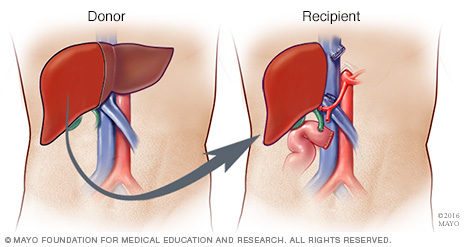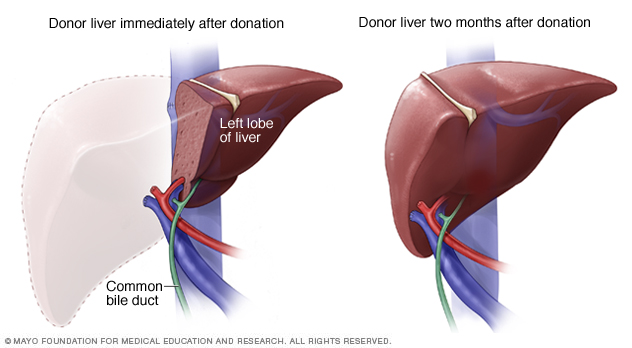Living-donor liver transplant
![]() March, 26th, 2025
March, 26th, 2025
Summary
Learn about this surgery that uses a portion of a liver from a healthy living donor to replace another person’s liver that’s not working properly.
Overview
, Overview, ,
Overview
A living-donor liver transplant is a surgery in which a portion of the liver from a healthy living person is removed and placed into someone whose liver is no longer working properly.
The donor’s remaining liver regrows and returns to its normal size, volume and capacity within a couple of months after the surgery. At the same time, the transplanted liver portion grows and restores normal liver function in the recipient.

During living-donor liver donation, surgeons remove a portion of the donor liver and place it into the recipient.

During living-donor liver donation, surgeons remove a portion of the donor liver and place it into the recipient.

Within a couple of months after living-donor liver surgery, the donor’s liver typically grows back to its previous size, volume and capacity.

Within a couple of months after living-donor liver surgery, the donor’s liver typically grows back to its previous size, volume and capacity.
Living-donor liver regeneration Why it’s done
The number of people waiting for a liver transplant greatly exceeds the number of available livers from deceased donors. Living-donor liver transplant offers an alternative to waiting for a deceased-donor liver.
Having a living donor also allows the recipient to avoid some possible health complications while waiting for a transplant. People who have a living-donor liver transplant seem to have fewer medical problems after the procedure than those who receive a liver from a deceased donor. A liver from a living donor also has a longer survival rate.
Living-donor liver transplants are more common among children who need a liver transplant than among adults because suitable deceased-donor organs are scarce.
Most living liver donors are close family members or friends of the liver transplant candidate. However, some people choose not to direct their donation, so it helps someone they don’t know. People who previously donated a kidney may be eligible to donate a portion of their liver.
What you can expect
Before the procedure
To be considered for a living-donor liver transplant, both the donor and recipient must undergo a thorough health and psychological evaluation at a transplant center. Separate transplant teams will care for the donor and recipient during the evaluation process and will discuss the potential benefits and risks of the procedure in detail.
For example, while the procedure often may be lifesaving for the recipient, donating a portion of a liver carries significant risks for the donor.
Matching of living-donor livers with recipients is based on age, blood type, organ size and other factors.
During the procedure
On the day of the transplant, surgeons will remove a portion of the donor’s liver for transplant through an incision in the stomach. The specific part of the liver donated depends on the size of the donor liver and the needs of the recipient.
Next, surgeons remove the recipient’s liver that’s not working properly and place the donated liver portion in the recipient’s body. They connect the blood vessels and bile ducts to the new liver.
The transplanted liver in the recipient and the portion left behind in the donor regrow rapidly, reaching normal liver volume and function within a couple of months.
People who receive a liver from a living donor often have better short-term survival rates than those who receive a deceased-donor liver. But comparing long-term results is difficult because people who get a living-donor liver usually have a shorter wait for a transplant and aren’t as sick as those who receive a liver from a deceased donor.
© 1998-2025 Mayo Foundation for Medical Education and Research (MFMER). All rights reserved. Terms of Use



